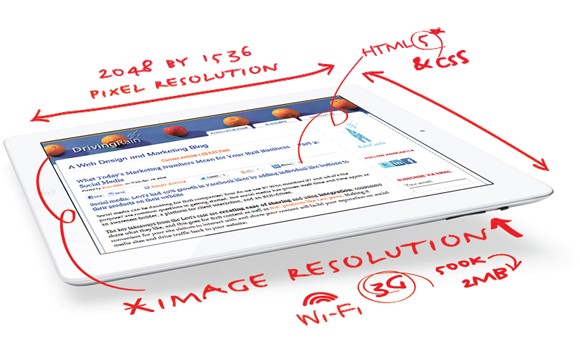What the New iPad Resolution Means for Your Website


Last week, we attended the New England Direct Marketing Association’s Marketing Technology Summit, and were treated to presenters from Google, Overdrive Interactive, HubSpot, Eloqua, and more. The conference centered on ways to utilize marketing technology to promote your brand, engage visitors, and create strong online relationships with future and current consumers.

That our clients have become more sophisticated web users is a reflection of the web not being a new medium anymore. We’re finding that our clients are increasingly thinking like information architects about how their audiences will navigate to desired content. It is a time for web designers to examine long-held notions of what constitutes a good UI.
It’s exciting to see the world of possibilities open up for B2B websites. In the past, B2B sites have often been “brochure-ware,” with predictable, one-size-fits-all content presented in a static drill-down hierarchy. One had to look at consumer sites, like amazon.com to understand the concept of a “user-driven” experience. Since website users were often transacting business, consumer sites innovated new ways to capture and keep their audiences, like amazon.com did with personalization.
On many occasions our clients say, “We want to be #1 in Google.”This is a worthy goal, but too general to result in success. It does however, lead to interesting follow-up questions, like “For which search terms do you wish to rank?”

I was talking to a European client this morning, He was asking me for examples of websites with navigation typical of an American company. While the client was perhaps looking for cultural distinctions, I thought that website navigation was an interesting topic and one that we are asked about often. The subject warrants a series of posts, so for the sake of brevity, this post will present the macro view. For this discussion, I will address the B2B space.
Well, almost. Regardless of the fact that we provide integrated services, often when a client comes to us for a website, they are not thinking about branding, yet it is often the issue that will make or break the website. Branding is often considered more of a consumer concern or maybe just an expensive “nice-to- have.” Of the six key components of a website development project — Content, Information Architecture, Search, Design, Interactivity and Programming — “content” is nearly always the chief area of focus, where the most time is expended and where differing opinions can affect outcomes and timing.